Rail freight is changing - longer trains are running, carrying different loads than in the past. But it is constrained as to how much it can grow.
Even so, it is one of the undoubted success stories of privatisation. Lumbered with an ageing fleet of locomotives from British Rail, Britain’s rail freight operators have since invested and innovated in new traction and new types of wagons.
And they have been assisted in their task of moving the country’s imports and exports - primarily between the ports and inland terminals - by investment from Network Rail (and its predecessor, Railtrack).
It is the relationship between NR and the freight operators that is particularly interesting. Each need the other, but freight operators are unlike their passenger counterparts - they are not franchised, and are more or less commercially free to do as they wish.
Paul McMahon, as Network Rail freight director, is there to manage that relationship, rather than take a hands-on role in the operational freight railway. He is responsible for the infrastructure element of rail freight at Network Rail.
But what is McMahon’s role in terms of the oversight of Britain’s rail freight flows? Is he a bridge between the various players, including the operators and industry associations?
“Our role is multi-faceted. At one level, NR is the biggest single buyer of rail freight in the country, through the engineering trains and through our haulage contract.” (Managed through the National Supply Chain, formerly the National Delivery Service).
“From the commercial freight side of things, at a simple level our job is to deliver the freight timetables, to provide the paths and good quality infrastructure, and to deliver the trains on time. But there is much more to it than that, in terms of market development - where freight flows are coming from and going to, and who wants to put what on the railway.
“If you go back a few years, NR didn’t have terrific knowledge and relationships with what we call the ‘end users’ - the people who ultimately choose to put their products on railways, whether it’s an aggregates company, a port, a power station or a supermarket.
“Anyone and everyone who is increasingly interested in rail, increasingly wants to put traffic on rail. Over the last couple of years, since the freight team was established, increasingly and intensively, we have actively gone out and strengthened our contacts and relationships with end users.”
There are many debates regarding investment, including electrification. RAIL highlights the calls made by various influential industry figures for more overhead wires (RAIL 757), and McMahon describes the debate over diesel versus electric traction as “complex”.
“While John and I see the benefits of electric traction, there is a pay-off; a compromise. The outlay of that infrastructure has to be borne in mind.”
RAIL notes that once you have wiring in, the trains are potentially lighter. An electric locomotive is “significantly” lighter than a diesel locomotive, and provides more power as well.
McMahon agrees: “The big win is in capacity and performance. You see new statistics every week about how busy the railway is, and what the growth projections are, whether it’s passenger or freight.
“If we run more trains on a mixed-use network, then ideally we are running freight with electric traction. And machines are lighter, so we do far less track damage. Clearly you have maintenance of the overheard wire, but the cost savings on track wear and tear are material.
“That’s before we have looked at acceleration and performance benefits.”
Outlining the core routes, McMahon adds: “The key intermodal freight flow at the moment is Felixstowe, so Freightliner runs electrics, for example. They will come down from Ipswich, the North London Line, the West Coast Main Line.
“Last June, under the guys at the Strategic Freight Network, we agreed the funding for phase two of the Felixstowe to Nuneaton (F2N) route, which is a terrific decision.”
Describing F2N as the “flagship” freight enhancement, McMahon says: “We have done bits and pieces in Control Period 4, but we’re now going to do a lot more - about £80 million of F2N investment.
“Plus there is investment on associated schemes that are being HLOS-funded - for example, around Leicester, which is wrapped up with the debate about the Electric Spine, Midland Main Line electrification and Leicester resignalling. As and when that is completed, instead of getting 30 freight trains out of the Port of Felixstowe, you can have 48 cross-country trains.”
What about the Electric Spine debate? What does that mean to McMahon? Are there points of disagreement?
“Obviously there is an effect on passenger trains as well, which is something a bit different, I guess.”
The Electric Spine is a CP5 project (April 2014-March 2019), for which the Government set out funding in the High Level Output Specification published in 2012, so it is in the Periodic Review. It’s all for the next five years, isn’t it?
McMahon admits he’s not close to the detail of what the electrification teams are looking at, but understands the debate with government.
The debate around Great Western electrification (and the costs of that) feeds into a wider discussion about electrification costs.
“There is an associated debate about the Spine, what that is, and where exactly that should go,” he says.
“For example, I have someone in my team who is working with electrification people, looking at the issue of the last mile problem for freight into and out of the outer terminals, and what you do there.”
It takes us back to traction, and whether there is a hybrid machine that could tow a heavy freight train for the last mile.
“I think there is a wider discussion about where it goes and what it does. Some people are angling, and saying that if we want to make electrification work for freight, then you have to electrify the Felixstowe branch line, so you can run electric all the way out of the port.”
Surely that makes sense?
“At the moment that’s not part of the F2N scheme. Ideally you would string up wires across the Fens, if you wanted to make the most and best use of the network for electrics. I think that will creep into the discussion. But as of today, there is no plan to do that.”
Are there particular points on the network where McMahon has identified a priority for making the most of electric traction - maybe off the West Coast or East Coast Main Lines, where he sees that sort of last mile technology working best?
Or does he see that as a question for the freight operators? Has NR, as an organisation, identified where dual-mode locomotives could operate in particular places, or is that something that has still to be worked through?
McMahon points to the dual-mode, electro-diesel Class 88 electric locomotive, which is on course to enter service in 2015 with Direct Rail Services.
“The freight operators are on their uppers, with thin profit margins. Do they have the capacity to fund the thin profit margins and remain competitive? Do they have the capacity to fund a new generation of machines themselves?
“Then along comes DRS. It has obviously spent a lot of money on the Class 68s it is bringing in, and on the Class 88s. Obviously John has done what he has done with the 21 Class 66s. Colas Rail has bought these Class 70s. Some of that is for use on the Network Rail haulage contract.”
McMahon says the freight operators have secured a lot of equipment for themselves.
“We are not actively looking to go in and do somebody else’s job for them. That’s not something we have ever done. We thought at the time it felt like it might be the thing we could help in some shape of form. In terms of bi-mode operation, and where that is necessary or works best, it is still early days.”
McMahon says he wants to see how progress with the electrification team is going, so is his role more about information gathering? Does NR need to know what customers want so it can then plan for the future in terms of the infrastructure?
“That’s spot on. One of our central roles in the industry is to develop those long-term plans for the infrastructure, and what demand is going to hit the railway in ten, 25, 30 years’ time - so very long-term plans.”
“Frankly, we are the only people that can do that, and we have been charged with leading that. The Strategic Rail Authority used to do a lot of that, and it is now down to NR, through the Route Utilisation Strategy programme and the long-term planning process.
“In order to understand what the traffic could be, we need to talk to the people who ultimately choose to put the traffic on rail. Drax Power Station, for example, sees a lot of trains in and out each day, and is absolutely dependent on the railways for its business.
“They might choose to use haulier A, B or C, or a mixture of all three. They might not be doing that tomorrow, they might not be doing it next year, because they will have their own contractual relationships and there may be certain things they don’t want to share with a freight operator, but they might be willing to share with NR as an independent middle-man.
McMahon says NR has built up good relationships with such customers, including members of his team who have been involved in rail freight for many years.
“We have put in a lot of effort collectively to strengthen those good, trusting relationships. People are happy to talk to us and share their views on rail, which aren’t always positive, and share their views on freight operators, which equally aren’t always positive. They share their business plans, and that is essential for us to get a richer picture of what is going on. We use that to inform our planning processes.”
McMahon acknowledges that certain individuals and certain freight operators didn’t like NR doing that, arguing that it is outside NR’s remit. But McMahon has always believed that “it’s absolutely the right thing to do”, adding: “Without that we are wholly reliant on what a freight operator tells us, and they might not be party to all the information. We know they are not, as there are things the end user tells us in confidence that they can’t tell freight operators, for one reason or another!”
Drax Power Station, which has invested hundreds of millions of pounds converting some of its units to burn biomass, imports raw material from the US. It has a huge supply chain to bring goods into UK, and is a good example of the way freight is evolving and changing from traditional flows such as coal.
But how else is freight changing?
Coal can sit in large stockpiles, but biomass is combustible if it gets damp, so has to be looked after carefully.
“The Port of Liverpool has invested significant amount of money to work on biomass as part of the Drax supply chain,” says McMahon. “Freight operations end users are saying on one level that NR needs to support biomass traffic.”
RAIL recalls another less apparent freight opportunity that could become more permanent at Euston station.
Night freight trials have taken place at the station - in partnership with NR, distribution firm TNT and Colas Rail - making the most of some otherwise redundant Motorail wagons to transport non-perishable goods into central London after the passenger trains have stopped running.
Battery-powered vans and hybrid lorries arrive via the parcels deck and Euston’s useful ramps, and then have goods transferred to them before scurrying away to deliver to the West End’s shops.
Is that a genuine opportunity, or is there a risk (with Euston being rebuilt in time for HS2) that it is nothing more than an interesting experiment? Is there an opportunity for light freight once more?
McMahon is open to the idea of a dedicated high-speed freight flow, perhaps in and out of Euston, King’s Cross or St Pancras.
“Wagon load didn’t work in the modern era, but if you have the growth of Amazon and internet shopping, everyone has everything delivered,” he says.
The prospect of high volume parcels, high value equipment, and perishable goods is “quite interesting”, according to McMahon.
“Standard engineering works. We will support it and are happy to talk to people who want to do more in that arena. People out there are talking about what sort of equipment you need.
“Someone has to try to make it work on a bit more of a scale, with more regularity, but supermarkets are interested. Emissions in central London are not going to make it easier for road traffic.”
There are paths on the network at night, but shops in central London could be replenished in the afternoon as well.
“It’s good to see TNT and others in the sector think quite carefully about it. We welcome those sort of initiatives, and do what we can to support them.”
At RAIL’s previous meeting with McMahon, we talked about whether NR was winning the argument over road freight - with the prospect of longer HGVs seemingly on the backburner. While road haulage has considerable advantages over rail freight in terms of flexibility, it doesn’t always win the economic argument.
“Talk to end users. They like rail. The economics of rail works.
“The service quality has improved immeasurably. Growing capacity on the network remains a challenge, not least because if you look at the freight forecast following a consultation and industry engagement last October, you see freight growing from a 2011 level to 2043 (which is the timescale we run it out to) by 140%.”
The number of trains has gone down, but the tonnage per kilometre has gone up - that’s about a 75% increase since privatisation, in terms of the amount of pure tonnage carried. It equates to roughly 100 million tonnes per annum, and that figure is increasingly slightly.
Says McMahon: “It’s increased over the last few years - the underlying growth is there. Intermodal, particularly, has grown. But we are not out of the era of austerity.”
Looking ahead, McMahon questions what funds might be available for Control Period 6 (2019-2024), adding: “And we haven’t put a spade in the ground yet for HS2. We need to ensure there is investment for specific freight intervention.”
Aside from the £38 billion set aside for CP5, McMahon says there has been around £200m in each of CP4 and CP5 for specific freight projects. “We have had to marshal our funds.”
He wants to “park HS2 to one side until we know it is definitely going ahead”, although he recognises that when it happens, it will create capacity for intermodal trains.
RAIL asks whether the future challenge will be to create more capacity, with more Ipswich curves, and dealing with bottlenecks in the network. Is there a list of projects McMahon want to prioritise, in what is left over in CP5?
“If we can identify those pinch points, where you can go in with a focused scheme, then that is the way to do it, rather than doing a grand scheme. Doncaster North Chord is another one to add to the list. Now we are starting processes to identify where some of those might be. Different people have thoughts of where those schemes might be.”
But planning constraints are tricky, and have eaten up a huge amount for the Strategic Freight Network. Perhaps the network therefore requires some sort of bold re-opening project to actually cope with the vast amount of freight. With the formations for many closed lines remaining in situ, can arguments be made for re-opening branches and long stretches of track that are not currently being used?
“The economics of finding a billion pounds or more are not simple,” says McMahon.
He looks at what has been delivered so far at the ports of Southampton and Felixstowe, and with more work under way over the next 18 months, he is keen to identify proposals for CP6 and beyond.
“We are not going to limit that. If there are bold and ambitious schemes, let’s bring those into the discussion. We want to look at the case for them.”
But the cost of engineering is always going to be considerable. McMahon says freight investment tends to be done incrementally, through the Strategic Freight Network.
“The freight market study highlights potential growth at 140%, an unconstrained forecast for the next 25 to 30 years. What would we need to do to make that happen, if we want to take the trucks off the road?
“Inevitably that won’t come on the cheap. I don’t want to undermine the case for freight. On the other hand, if we want to see freight grow, what do we need to do to make that happen in an efficient way?”
He says a really well-researched study into needs is therefore required.
“It can range from specific interventions - from building a chord, or moving a signal to allow longer trains to run - to something a bit bolder.
“It plays into the capacity debate. Look at freight paths today. There are up to around 800 freight trains, but there are 2,000 paths in a working timetable. There is quite a lot of freight capacity unused.”
It is certainly an issue on a growing railway. RAIL recalls freight trains running through Kensington Olympia (on lines shared with London Overground and Southern) in rush hour - but there is obviously a need to run freight trains at that time. Surely there must be a conflict here?
“There is a curfew in London. Freight trains drop down in the peaks in London. Watford, Stratford or further afield, numbers drop in those hours. Transport for London needs to run more intensive services.”
But a good railway is one that needs to interact well with freight flows. McMahon can see freight on the North London Line from his office, with container trains running in and out of Felixstowe, yet he knows that the Felixstowe to Nuneaton scheme (when complete) will allow more freight to run cross-country. Is having that sort of mixed traffic unsustainable in the long term?
“Unsustainable is an emotive term. By sorting out Felixstowe to Nuneaton, my hunch is that would be hugely beneficial to the economy and rail sector. It will be a few years before we get there. We are putting a lot of focus on the F2N scheme to drive it forward and make that happen.
“But we have to segregate freight from passenger. Doncaster, on the East Coast Main Line, is a cracking example. There’s a time saving for freight trains going into power stations. It’s hugely beneficial.
“We need to make better use of the capacity we have.”
- This feature was published in RAIL 760 on 29 October 2014

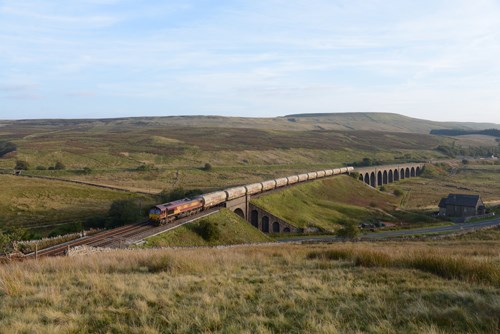
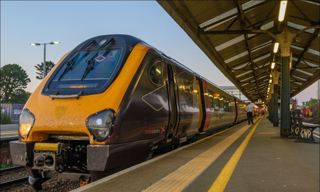
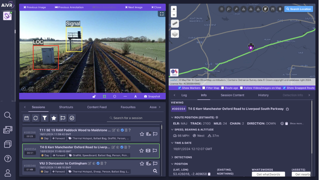
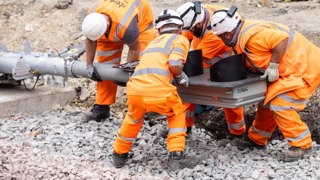
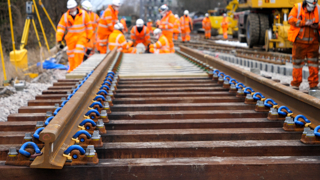










FrankH - 07/06/2017 23:47
I wonder what the freight director has to say about the recent idea mentioned by lord berkeley in this months magazine. A certain double headed electric freight over the WCML (they're all double headed these days since the 92's have ceased use) will have to go to using 1 loco since it draws to much power. The majority of electric hauled freight is timed for 1235 or 1250 tons. 2 are 1650 tons (1910 ex Daventry - Mossend) and 0539 in the other direction. The 1800 tonner is Dollands Moor - Irvine which runs weekly. The reason, the passenger trains can't draw enough power as the supply hasn't replenished itself after the freight has passed ( it's as close as I can remember). And NR can't upgrade the power supply, no funds. Not long ago I'm sure we were talking about longer faster freight electric powered.